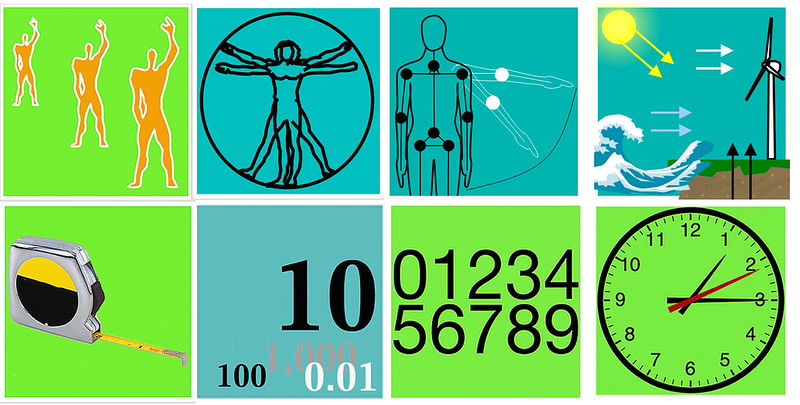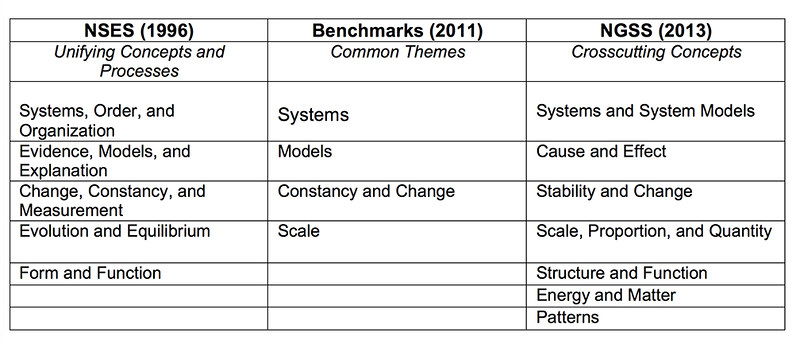NEXT.cc Notes Scale, Proportion, and Quantity
“In disputes about natural phenomena…one must begin with experiences and necessary demonstrations.” Galileo Galilei

Think of this post as a CliffsNotes edition of the crosscutting concepts, Scale, Proportion, and Quantity – a quick study guide, which, to paraphrase the original CliffsNotes, “serves as starting point to open yourself to new methods of encountering, understanding, and appreciating” these essential concepts.(1)NEXTNotes begins with a brief introduction to an instructional strategy that is heavy on experiential learning. It highlights essential concepts relating to scale, proportion, and quantity, and then identifies the specific concepts that appear in the NGSS Performance Expectations. Best of all, NEXTNotes includes new resources for the study of scale, proportion, and quantity – links to lessons, student activities, and interactive simulations, with many aligned to performance expectations in the Next Generation Science Standards.
Experiences First
In Kristin L. Gunckel’s Web Seminar on the NGSS Crosscutting Concept, Patterns, the University of Arizona Associate Professor turns the traditional experience of school science upside down with a concise sequence of instructional steps that end, rather than begin with Explanations.(2) In contrast to much textbook science, which emphasizes explanations, which are then confirmed or disproved by students, Gunckel argues that students must begin with Experiences. Like a pyramid, instruction should begin with a wide foundation - with “Millions of Experiences with phenomena;” proceed to “Dozens of Patterns (laws, generalizations, graphs, charts);” leading to “A few models, theories, and Explanations.” Gunckel’s focus is the Cross Cutting Concept, Patterns; however, the idea of proceeding from many experiences to a concept, or generalization, and then to explanations has value across the curriculum. In keeping with Gunckel’s suggestions, and the wisdom of Galileo, NEXTNotes presents “millions” of resources for students to experience the crosscutting concepts, Scale, Proportion, and Quantity.
Evolution of the Crosscutting Concepts
The Crosscutting Concepts in the NGSS have evolved from the Unifying Concepts and processes that appear in the National Science Education Standards (NSES) and the Common Themes in the Benchmarks for Science Literacy.(3) Consequently, many of the concepts are already incorporated in instructional materials and the working knowledge of veteran teachers. The NGSS reshuffle the five unifying concepts from the NSES and the four Common Themes from the Benchmarks into a new deck of seven concepts.

The following essential ideas distill the accumulated knowledge and wisdom about crosscutting concepts as they appear in the NGSS.
•Crosscutting Concepts are “concepts that bridge disciplinary boundaries, having explanatory value throughout much of science and engineering.”
•“Crosscutting Concepts are not the intellectual property of any one field or discipline.” They are “intellectual tools,” or “ways of thinking rather than theories or discoveries.”
•“The concepts need to be made explicit for students because they provide an organization schema for interrelating knowledge from various science fields into a coherent and scientifically based view of the world.”
•Repetition of Crosscutting Concepts in different contexts will be necessary to build students’ familiarity with the concepts.
•“Crosscutting Concepts should grow in complexity and sophistication across the grades.”
Scale, Proportion, and Quantity in Next Generation Science Standards
With the publication of the Framework in 2012, and the NGSS in 2013, there has appeared a growing body of literature and instructional resources addressing the Crosscutting Concepts. The recurrence of the following ideas suggest that we should pay attention to these insights when teaching or learning about Scale, Proportion, and Quantity.
•Scale, proportion, and quantity are fundamental assessments of dimensions that form the foundation of observations about nature. They are the starting point for scientific understanding.
•From a human perspective, we separate three major scales at which to study science: (1) macroscopic scales that are directly observable—that is, what one can see, touch, feel, or manipulate; (2) scales that are too small or fast to observe directly; and (3) those that are too large or too slow.
•The Universe varies along three continuums: size, timespan, and energy.
•Particularly important senses of scale to develop for science literacy are the immense size of the cosmos, the minute size of molecules, and the enormous age of the earth (and the life on it).
•To appreciate the relative magnitude of some properties or processes, it may be necessary to grasp the relationships among different types of quantities—for example, speed as the ratio of distance traveled to time taken, or density as a ratio of mass to volume.
•In considering phenomena, it is critical to recognize what is relevant at different measures of size, time, and energy, e.g., as size scales change, so do time and energy scales.
•Different aspects of nature change at different rates with changes in scale, and so the relationships among them change, too. For example, as something changes size, its volume changes out of proportion to its area. So properties that depend on volume (such as mass and heat capacity) increase faster than properties that depend on area (such as bone strength and cooling surface).
•It is critical to understand how changes in scale, proportion, or quantity affect a system’s structure or performance. Things necessarily work differently on different scales, e.g., strength of different-sized constructions from the same material, flight characteristics of different-sized model airplanes.
A Study Guide To Scale, Proportion and Quantity in the NEXT Generation Science Standards
In the “DCI Arrangements of the Next Generation Science Standards,” the crosscutting concepts are articulated in statements presented with Disciplinary Core Ideas and Science and Engineering Practices.(4) The three dimensions are then united in and aligned with specific Performance Expectations. In keeping with the belief that, “Crosscutting concepts should grow in complexity and sophistication across the grades,” the NGSS provide a general statement for each of the crosscutting concepts, followed by a progression of ideas to be introduced in the primary grades through high school. The statements apply concepts of scale, proportion, and quantity to continuums of size, time, and energy flow across the science curriculum. The statements also associate the concept of standard units to measurements of weight, time, temperature, and volume.
In a Study Guide to Scale, Proportion, and Quantity: Crosscutting Concepts, NGSS Performance Expectations, and DCIs, attached here, teachers will find each of the Performance Expectations for grades K-8 that are aligned with the Crosscutting Concept, Scale, Proportion, and Quantity. Designed as a one-stop study guide, the document consolidates information for Scale, Proportion, and Quantity as it appears in the three dimensions of the Next Generation Standards for Life, Physical, and Earth and Space Science.
New Resources for Teachers and Students
Despite the misconceptions of some, the NGSS are not a curriculum. They tell what should be taught, not how, and leave the valuable work of curriculum development to others. Across the country, university consortia, commercial developers, school districts, and individual teachers keep the wind turbines spinning as they create an impressive and growing array of curriculum materials that bring the standards to life in classrooms and homes throughout the U.S. At NEXT.cc, we take pride in our contributions to that work.
With nearly 250 learning Journeys and over 10,000 links, NEXT.cc is a microcosm of the Internet, itself. An eco web that develops ethical imagination and environmental stewardship, NEXT.cc introduces students of all ages to design learning through Journeys that cross discipline boundaries and bridge the arts and sciences. At NEXT.cc, learners will find Journeys that are devoted specifically to cross cutting concepts, including Scale and Proportion. Others address the three continua along which the universe varies - Time, Energy, and Size (Measure). Still others are devoted to topics that incorporate Scale, Proportion, and Quantity within NGSS Performance Expectations, for example PEs that ask students to describe and graph the amounts and percentages of water and fresh water in various reservoirs Water Journey, or to construct an explanation based on evidence for how geoscience processes have changed Earth’s surface at varying time and spatial scales Earth Journey. Within the Journeys, themselves, links to additional resources that support the understanding of Scale, Proportion, and Quantity multiply.
Now, NEXTNotes brings new resources, including many that are aligned with the NGSS Performance Expectations. In New Resources for Teachers and Students: Scale, Proportion and Quantity, we present links to lesson plans, labs, and interactive simulations that provide students experiences that will help them form meaningful concepts of scale, proportion, and quantity. The resources, which are linked within NEXT.cc Journeys, are organized in New Resources to support instruction in Life, Physical, and Earth and Space Sciences. New Resources also includes materials aimed at building students’ understanding of standardization and standard units.
With NEXTNotes at your side, we invite you to explore the concepts and resources presented here, along with NEXT.cc’s many learning Journeys. Whether you’re planning lessons, searching for differentiated learning experiences, or assigning homework, let NEXTNotes be your guide.
(1) “A Brief History,” About CliffsNotes, Houghton, Mifflin Harcourt. Accessed September 15, 2016. https://www.cliffsnotes.com/discover-about)
(2) Gunckel, Kristin. “Crosscutting Concepts: Patterns.” NSTA Web Seminars. Archived at http://learningcenter.nsta.org/products/symposia_seminars/ngss/files/NGSSCrosscuttingConcepts–Patterns_2-19-2013.pdf
(3) National Research Council. (1996). National Science Education Standards. National Committee for Science Education Standards and Assessment. Washington, DC: National Academy Press. Accessed September 16, 2016. https://www.nap.edu/read/4962/chapter/8#104
American Association for the Advancement of Science: Project 2061. (1993). Benchmarks for Science Literacy. Accessed September 16, 2016. http://www.project2061.org/publications/bsl/online/index.php?txtRef=http%3A%2F%2Fwww%2Eproject2061%2Eorg%2Fpublications%2Fbsl%2Fdefault%2Ehtm%3FtxtRef%3D%26txtURIOld%3D%252Ftools%252Fbsl%252Fdefault%2Ehtm&txtURIOld=%2Fpublications%2Fbsl%2Fonline%2Fbolintro%2Ehtm[June 2011].
(4) DCI Arrangements of the Next Generation Science Standards.


















































